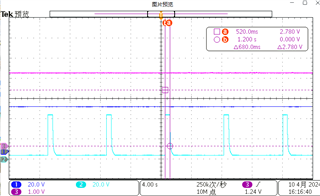HI TI Expert!
When I used bq76952 to control the FET, I used low-side FET. When undervoltage protection occurred, the CHG FET seemed to turn off abnormally. When undervoltage protection occurred, the device actively turned off the DSG FET. Then the host uses commands to close the CHG FET, but the CHG FET is closed and then opened in the middle.
The oscilloscope shows light blue is DCHG , pink is DDSG, the process is undervoltage, and then CUV Delay 0x01, CHG FET is closed by the host using the command.

Here is my configuration.
DCHG 0xA2;
DDSG 0xA2;
CFETOFF 0x02;
DFETOFF 0x02;
FET_CHG_PUMP_CONTROL 0x00;
Want to know what causes this and how to solve the problem?
Look forward to your answer, thank you


